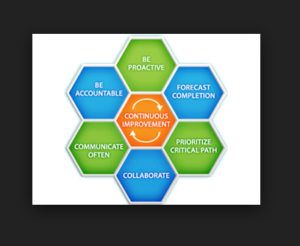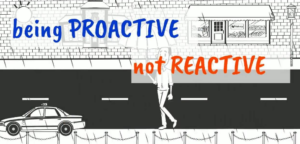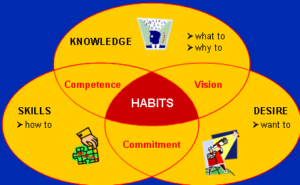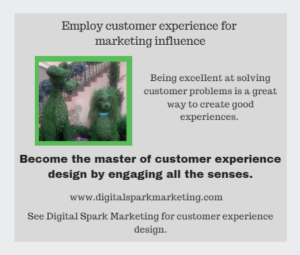In the process of researching what makes people most successful, I read many, many interviews and bios of people I believed to set the standard. These included dozens of successful leaders, from world-class scientists seeking to cure cancer and create new computing architectures, to senior executives at large corporations and entrepreneurs at startups. It was a very diverse group with the habits of highly successful Brad Pitt.

One of the underlying premises I have concluded is that there is no one “true” path to innovation, so I expected to see a variety of approaches, and that’s indeed what I found.
Some of the people were slow and deliberate, spending years or even decades on a difficult problem. Others were fast and agile, iterating and pivoted toward a viable solution.
However, I also noticed that some remarkably constant themes emerged. Over time, it became clear that while the people were vastly different in background, training, personality type and method, they tended to have four attributes in common.
While none of these will make you a success by themselves, you are unlikely to be successful without them.
Thinking Positive Tips: 10 I Have Learned from My Peers and Mentors
Love the challenge of big problems
The most striking thing I noticed in my research was how successful people approached problems. They didn’t wait for them to arise but actively sought them out. It is that passion for solving problems, rather than any particular personality type or ambition, that separates all of them from most people and organizations.
Experian, for example, set up a special unit to seek out and solve its customers toughest problems. IBM regularly sets up “grand challenges,” like developing a system that can beat humans at Jeopardy!. Steve Blank, whose ideas inspired the Lean Startup movement, encourages entrepreneurs to “get out of the building” and talk to customers.
One of the most interesting people was Jim Allison. Low-key to the extreme, he’s the type of guy who you would scarcely notice in a room. As a boy, he decided to be a scientist because he just liked “figuring things out.” So for more than 20 years, that’s what he did, sought out gaps in our understanding of the immune system and tried to figure them out.
But in the mid-90’s he had what turned out to be a revolutionary idea. His decades of study led him to believe that our bodies were shutting off the immune system too early to fight cancer. It was this insight that led him to develop cancer immunotherapy, which today is considered a miracle cure that saves the lives of thousands of terminally ill patients who once had no hope.
Allison is an extreme case, but I found that most successful people had some version of the same story. Most never dreamed they would do anything important; they were just trying to solve a problem.

Highly successful Brad Pitt … overcome failure
Not all of Jim Allison’s story was happy. In fact, after he had his initial breakthrough, he spent three years trying to convince pharmaceutical companies to back his idea. There were no takers.
This is more common than you would think. Often, the stories we hear about great success are fairy tale versions that gloss over the uncomfortable parts. We hear about the triumphs, but not the frustrations and so we mistakenly believe that successes are supposed to come to us as magical epiphanies.
Consider the case of Alexander Fleming. We often hear about how he discovered penicillin when the bacteria colonies he was growing became contaminated by a mysterious mold. What is rarely mentioned is that his discovery couldn’t have cured anyone and that it was another team altogether which made penicillin into a useful drug.
The truth is that success is not a single event and rarely is it ever accomplished by a single person. It often takes decades for a fundamental discovery to have an impact on the world and along the way countless people play a part in making it happen.
Highly successful Brad Pitt … have the vision, yet flexible
When Alph Bingham was a chemistry graduate student at Stanford in the 1970s, he was struck by how many ways there were to approach a tough research question.
So when he first came up with the idea that became InnoCentive at Eli Lilly in the late 1990s, he envisioned a platform that would work much the same way. It would allow chemists to post unsolved problems to attract insights from other chemists.
What he found though was that most of the time answers came from some adjacent field, like physics or biology. So it became important to encourage experts on the platform to cross disciplines.
Something similar happened when Children’s Health in Dallas set out to create a new program that would go beyond simply delivering care by going out into the communities to address the social determinants of health. At first, it seemed clear that the best way to do that would be to leverage the hospital’s primary centers.
Alas, the plan proved to be unworkable. So it created an entirely new infrastructure made up of health care navigators who help families connect with other resources in their community, such as Children’s Health and Wellness Alliance, a nonprofit that weaves together more than 100 community resources such as schools, social service, and faith-based organizations.
Just about every story I came across had an initial vision that was flawed in some way. So to be effective, successful people need to be quick to recognize problems and pivot to add new ideas.

Love to collaborate and work in teams
These people are simply happy to pitch in wherever they can be of help. The most successful people tend to be great collaborators.
I think this last attribute is the most telling. If you are working for your glorification, it’s hard to seek out hard problems, to accept inevitable failures, to be flexible and to give credit to others, because all of those things undermine your ego. The most successful people, on the other hand, are motivated by the problems themselves, and that makes all the difference.
Let me give you an example. A little while back, my wife was talking to me about something she was reading. One of the things she said was she found it hard to come up with ideas, given that there’s only so much you can talk about plot and print.
I asked her if she’d ever considered being more personal. Let readers get to know the real person behind the author.
What inspires here; what she’s afraid of; what her goals are beyond common family themes.
From my experience, even though I stopped writing directly about business on my blog in 2014, I still get business inquiries, along with emails and comments on how certain posts aren’t restricted to the personal topic I’ve written about.
Which makes sense – because our whole lives are one big blog post idea.
The beauty of the sunset, and how that can inspire a new beginning in business when the next dawn rises;
The innocence of children, and how that can make us better business leaders without ego or ignorance fuelling us;
The friendly neighbor who’ll do anything to another human, and how that can make us more accountable as colleagues;
The love of our pets, and how that can instill the importance of loyalty and reward when it comes to our customers.
These are just some ways that everyday occurrences can result in a business lesson. Which can then be turned into a piece of content?
Highly successful Brad Pitt … success habit strategies
There are many ways to design an environment that promotes success.
Here are three strategies:
Automate good decisions
Whenever possible, design an environment that makes good decisions for you. For example, buying smaller plates can help you lose weight by deciding portion size for you.
A study from Brian Wansink at Cornell University found that people eat 22 percent less food by switching from 12-inch dinner plates to 10-inch plates. Similarly, using software to block social media sites can help overcome procrastination by putting your willpower on autopilot.
Highly successful Brad Pitt … get in the flow
A few years ago, PetSmart changed their checkout process. After swiping their credit card, customers were shown a screen that asked if they wanted to donate to “help save homeless animals.” Through this single strategy, PetSmart Charities raised $40 million in a year.
You can apply a similar strategy by designing an environment where good habits “get in the flow” of your normal behaviors. For example, if you want to practice a musical instrument, you could place it in the middle of your living room.
Similarly, you are more likely to go to the gym if it is literally on the way home from work than you are if the gym is only five minutes away, but in the opposite direction of your commute. Whenever possible, design your habits so they fit in the flow of your current patterns.
Eliminate negative influences
Ancient farmers didn’t have the opportunity to remove the barriers that held them back, but you do. For example, Japanese television manufacturers rearranged their workspaces to save time by eliminating unnecessary turning, bending and swiveling.
You can also reduce the negative influences in your environment. For example, you can make it easier to avoid unhealthy foods by storing them in less visible places. (Foods that are placed at eye level tend to be purchased and eaten more frequently.)
The bottom line
If there’s one thing about the success that I’ve found to be true, both in business and in life, it’s this – people relate to real life.
If your people (your customers, your colleagues, your clients, your readers) can relate to your life and all you learn from it, it’s pretty much a guarantee that the goals you have will be easier to meet.
Try it – you might just find out it’s all you needed to do, to begin with.

Need some help in finding ways to grow your customers? Such as creative ideas to help the differentiation with potential customers? Or perhaps finding ways to work with other businesses?
Call today for a FREE consultation or a FREE quote. Learn about some options to scope your job.
Call Mike at 607-725-8240.
So what’s the conclusion? The conclusion is there is no conclusion. There is only the next step. And that next step is completely up to you. But believe in the effectiveness of collaborative innovation. And put it to good use in adapting to changes in your business environment.
It’s up to you to keep improving your learning and experience with innovation and creativity efforts. Lessons are all around you. In this case, your competitor may be providing the ideas and or inspiration. But the key is in knowing that it is within you already.
All you get is what you bring to the fight. And that fight gets better every day you learn and apply new lessons.
When things go wrong, what’s most important is your next step.
Try. Learn. Improve. Repeat.
When things are not what you want them to be, what’s most important is your next step. Call today.
Are you devoting enough energy to improving your continuous learning for yourself and your team?
Digital Spark Marketing will stretch your thinking and your ability to adapt to change. We also provide some fun and inspiration along the way. Call us for a free quote today. You will be amazed at how reasonable we will be.
Check out these additional articles on business and its performance from our library:
The Business Intelligence Process Part 3 Competitive Analysis
Competitive Growth Strategy … the Story of In-N-Out Burger
10 Entrepreneur Lessons You Need to Know
Collaboration and Partnerships Are Key to Business Growth
9 Favorite Work Life Productivity Apps
13 Amazing Facts about Google I’ll Bet You Didn’t Know
Mike Schoultz is a digital marketing and customer service expert. With 48 years of business experience, he consults on and writes about topics to help improve the performance of small business. Find him on G+, Facebook, Twitter, Digital Spark Marketing, and LinkedIn.